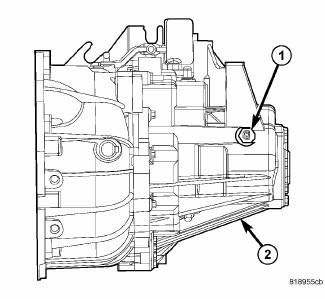Dodge Journey: Switch, backup lamp
DESCRIPTION

Fig. 43: Backup Lamp Switch
Vehicles equipped with a manual transmission (2) have a normally open, spring-loaded plunger type backup lamp switch (1). Vehicles with an optional electronic automatic transmission have a Transmission Range Sensor (TRS) that is used to perform several functions, including that of the backup lamp switch. The TRS is described in further detail elsewhere in this service information. Refer to the service and diagnostic information for the automatic transmission type installed in the vehicle.
The backup lamp switch is located in a threaded hole on the left facing surface of the manual transmission housing. The switch has a threaded body and a hex formation near the plunger end of the switch. An integral connector receptacle at the end of the switch opposite the plunger connects the switch to the vehicle electrical system through a take out and connector of the engine wire harness. When installed, only the switch connector and the hex formation are visible on the outside of the transmission housing.
The backup lamp switch cannot be adjusted or repaired and, if ineffective or damaged, the entire switch unit must be replaced. Refer to the service and diagnostic information for the manual transmission type installed in the vehicle.
OPERATION
The backup lamp switch controls a path to ground for the Totally Integrated Power Module (TIPM) on the reverse switch signal circuit. The TIPM reads this input through an internal pull-up, then controls an output through a high side driver that regulates the flow of battery voltage to the backup lamp bulbs as appropriate on the backup lamp feed circuit. The switch plunger is mechanically actuated by the gearshift mechanism within the transmission, which will depress the switch plunger and close the switch contacts whenever the REVERSE gear has been selected. The switch receives ground at all times through a take out and eyelet terminal of the wire harness that is secured to the body sheet metal.
The backup lamp switch as well as the hard wired inputs and outputs of the switch may be diagnosed using conventional diagnostic tools and procedures. However, conventional diagnostic methods will not prove conclusive in the diagnosis of the electronic controls and communication between other modules and devices that rely upon inputs from the backup lamp switch. The most reliable, efficient, and accurate means to diagnose the electronic controls and communication related to backup lamp switch operation requires the use of a diagnostic scan tool. Refer to the appropriate diagnostic information.
DIAGNOSIS AND TESTING
BACKUP LAMP SWITCH
1. Disconnect and isolate the battery negative cable.
2. Locate and disconnect the engine wire harness connector from the backup lamp switch connector receptacle.
3. Check for continuity between the two terminal pins in the backup lamp switch connector receptacle.
- With the gear selector lever in the REVERSE position, there should be continuity.
- With the gear selector lever in any position other than REVERSE, there should be no continuity.
4. If the switch fails either of these two continuity tests, replace the ineffective backup lamp switch.
 Relay, trailer tow
Relay, trailer tow
DESCRIPTION
Fig. 40: Identifying Relay & Terminals
Vehicles equipped with an optional trailer tow preparation package have four
trailer tow relays, one each for the
trailer tow stop/turn ri ...
 Switch, hazard warning
Switch, hazard warning
DESCRIPTION
Fig. 44: Instrument Panel Switch Pod
The hazard switch (3) is integral to the instrument panel switch pod (1),
which is secured to the instrument
panel center bezel just above the h ...
See also:
TO OPEN AND CLOSE THE HOOD
Two latches must be released to open the hood.
1. Pull the hood release lever located under the left side
of the instrument panel.
Hood Release
2. Outside of the vehicle, locate the safety latch ...
Removal
1. Disconnect and isolate battery negative cable from battery post.
Fig. 70: BRAKE PEDAL HOLDING TOOL
2. Using a brake pedal holding tool as shown, depress brake pedal past its
first inch of tra ...
Installation
CAUTION: To prevent damage to the plastic evaporator tube bracket,
carefully guide
the heater core tubes past the bracket during installation of the heater
core.
Fig. 278: Re ...
